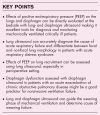Setting positive end-expiratory pressure: lung and diaphragm ultrasound
- PMID: 38085883
- PMCID: PMC10962429
- DOI: 10.1097/MCC.0000000000001119
Setting positive end-expiratory pressure: lung and diaphragm ultrasound
Abstract
Purpose of review: The purpose of this review is to summarize the role of lung ultrasound and diaphragm ultrasound in guiding ventilator settings with an emphasis on positive end-expiratory pressure (PEEP). Recent advances for using ultrasound to assess the effects of PEEP on the lungs and diaphragm are discussed.
Recent findings: Lung ultrasound can accurately diagnose the cause of acute respiratory failure, including acute respiratory distress syndrome and can identify focal and nonfocal lung morphology in these patients. This is essential in determining optimal ventilator strategy and PEEP level. Assessment of the effect of PEEP on lung recruitment using lung ultrasound is promising, especially in the perioperative setting. Diaphragm ultrasound can monitor the effects of PEEP on the diaphragm, but this needs further validation. In patients with an acute exacerbation of chronic obstructive pulmonary disease, diaphragm ultrasound can be used to predict noninvasive ventilation failure. Lung and diaphragm ultrasound can be used to predict weaning outcome and accurately diagnose the cause of weaning failure.
Summary: Lung and diaphragm ultrasound are useful for diagnosing the cause of respiratory failure and subsequently setting the ventilator including PEEP. Effects of PEEP on lung and diaphragm can be monitored using ultrasound.
Copyright © 2023 Wolters Kluwer Health, Inc. All rights reserved.
Conflict of interest statement
Figures





Similar articles
-
Ventilator Management(Archived).2023 Mar 27. In: StatPearls [Internet]. Treasure Island (FL): StatPearls Publishing; 2025 Jan–. 2023 Mar 27. In: StatPearls [Internet]. Treasure Island (FL): StatPearls Publishing; 2025 Jan–. PMID: 28846232 Free Books & Documents.
-
Diagnostic performance of the recruitment-to-inflation ratio to assess lung recruitability by PEEP in ARDS. a computed tomography study.Crit Care. 2025 Jun 3;29(1):220. doi: 10.1186/s13054-025-05453-0. Crit Care. 2025. PMID: 40462166 Free PMC article.
-
Positioning for acute respiratory distress in hospitalised infants and children.Cochrane Database Syst Rev. 2022 Jun 6;6(6):CD003645. doi: 10.1002/14651858.CD003645.pub4. Cochrane Database Syst Rev. 2022. PMID: 35661343 Free PMC article.
-
High versus low positive end-expiratory pressure (PEEP) levels for mechanically ventilated adult patients with acute lung injury and acute respiratory distress syndrome.Cochrane Database Syst Rev. 2013 Jun 6;2013(6):CD009098. doi: 10.1002/14651858.CD009098.pub2. Cochrane Database Syst Rev. 2013. Update in: Cochrane Database Syst Rev. 2021 Mar 30;3:CD009098. doi: 10.1002/14651858.CD009098.pub3. PMID: 23740697 Free PMC article. Updated.
-
Pressure-controlled versus volume-controlled ventilation for acute respiratory failure due to acute lung injury (ALI) or acute respiratory distress syndrome (ARDS).Cochrane Database Syst Rev. 2015 Jan 14;1(1):CD008807. doi: 10.1002/14651858.CD008807.pub2. Cochrane Database Syst Rev. 2015. PMID: 25586462 Free PMC article.
Cited by
-
Diaphragm ultrasound in patients with prolonged weaning from mechanical ventilation.Quant Imaging Med Surg. 2024 May 1;14(5):3248-3263. doi: 10.21037/qims-23-1712. Epub 2024 Apr 23. Quant Imaging Med Surg. 2024. PMID: 38720844 Free PMC article.
-
Is "Optimized Recruitment" Really Worth the Effort?Respir Care. 2024 Nov 18;69(12):1610-1613. doi: 10.4187/respcare.12463. Respir Care. 2024. PMID: 39557519 No abstract available.
-
Clinical management of sepsis-associated acute respiratory distress syndrome: current evidence and future directions.Front Med (Lausanne). 2025 May 26;12:1531275. doi: 10.3389/fmed.2025.1531275. eCollection 2025. Front Med (Lausanne). 2025. PMID: 40491760 Free PMC article. Review.
References
-
- Haaksma ME, Smit JM, Boussuges A, et al. . EXpert consensus on diaphragm ultrasonography in the critically ill (EXODUS): a Delphi consensus statement on the measurement of diaphragm ultrasound-derived parameters in a critical care setting. Crit Care 2022; 26:1–9. - PMC - PubMed
-
This is an expert consensus on diaphragm ultrasound measurements.
-
- Smit JM, Haaksma ME, Winkler MH, et al. . Lung ultrasound in a tertiary intensive care unit population: a diagnostic accuracy study. Crit Care 2021; 25:1–9. - PMC - PubMed
-
This is prospective observational study demonstrating the diagnostic accuracy of lung ultrasound compared to computed tomography. It highlights also the presence of multiple respiratory conditions per critically ill patient.
Publication types
MeSH terms
LinkOut - more resources
Full Text Sources
Medical
Research Materials

